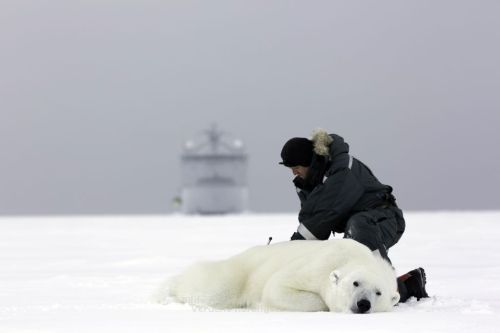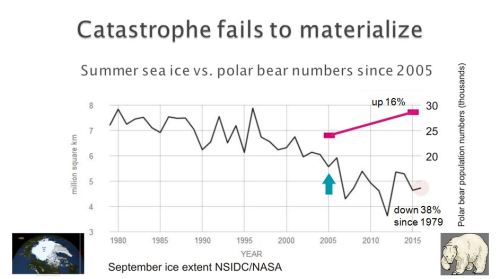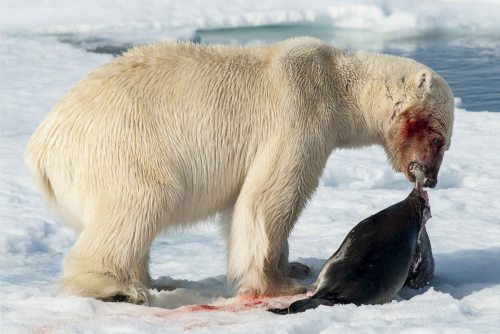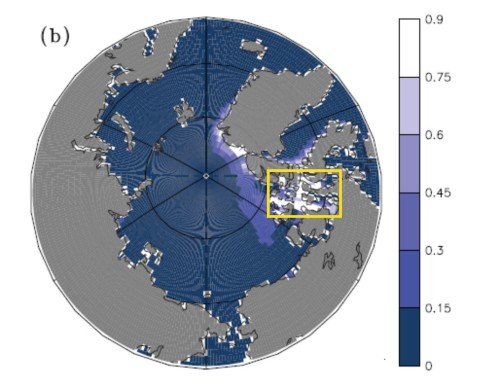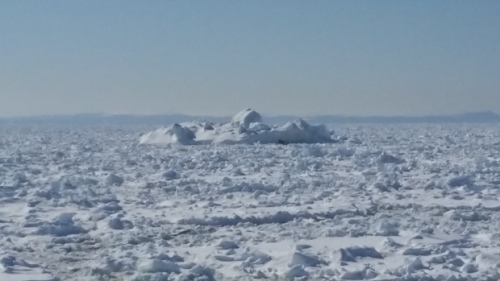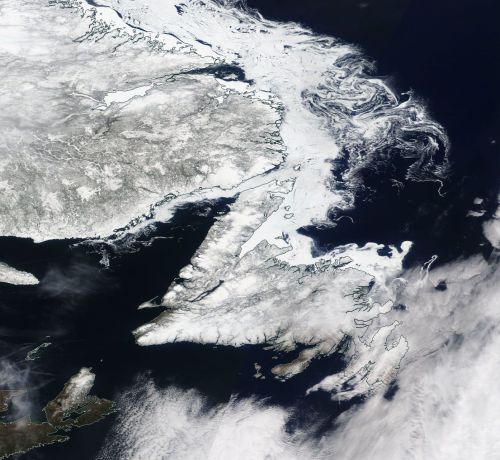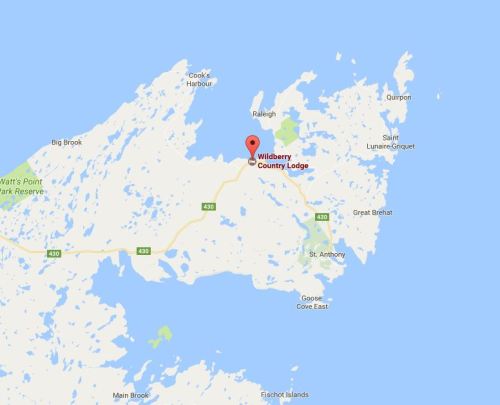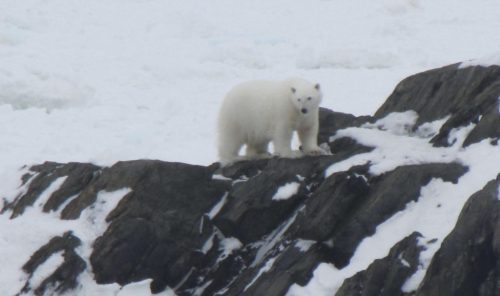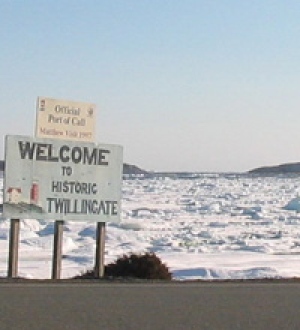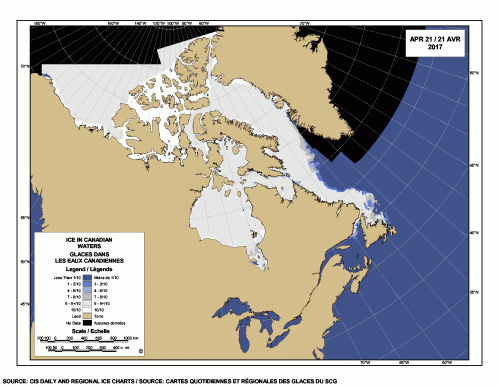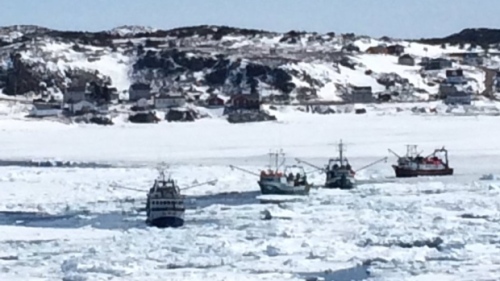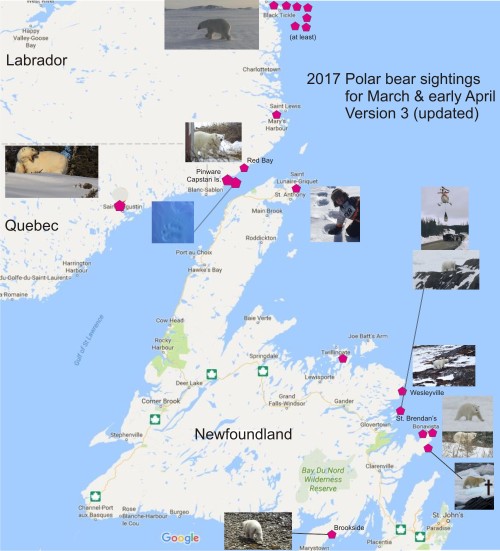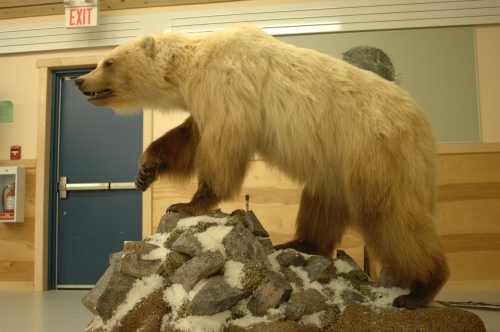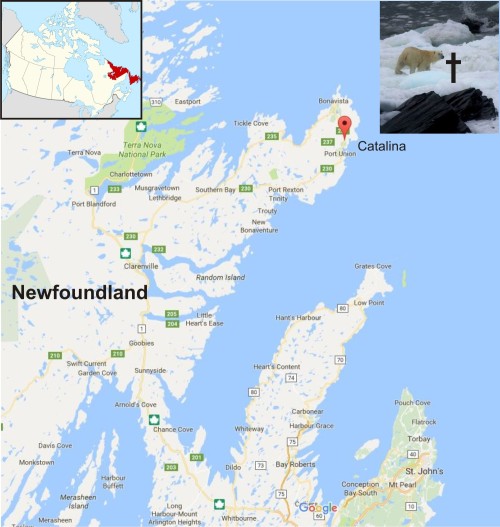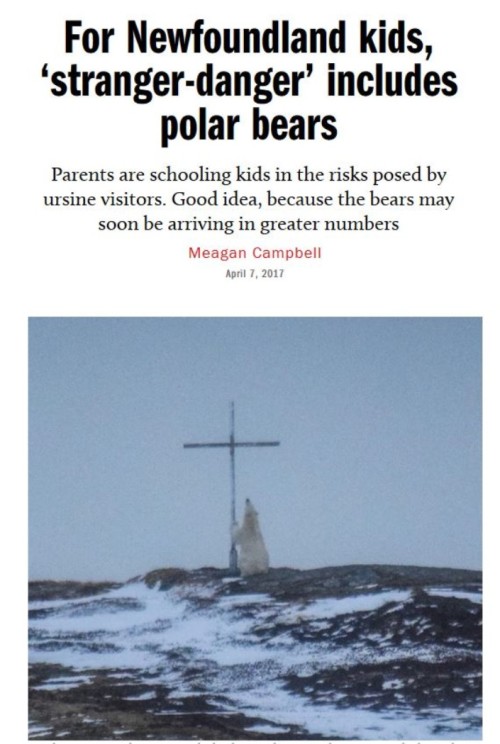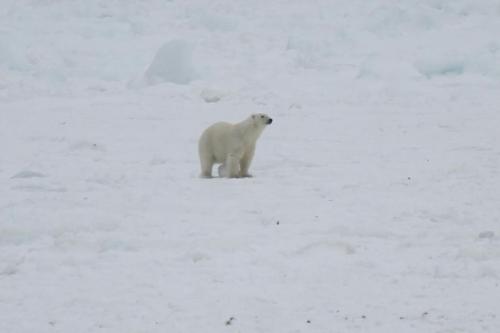Currently polar bear populations are in dire shape with a rapidly declining North pole
Polar bear numbers have risen since 2005, no matter how you look at it:
USGS estimated 24,500 (average) polar bears in 2005.
IUCN estimated 26,500 (average of 22,000-31,000) in 2015
(assessment completed in July, released in November).
Subpopulation surveys completed or reported after July 2015 (Baffin Bay, Kane Basin, Barents Sea) added ~2,000 bears.
This brings the adjusted average total at 2015 to ~28,500.
This may not be a statistically significant increase but it is also not the catastrophic decline that was predicted to occur in association with the abrupt drop of summer sea ice in 2007 to a new average of about 3-5 mkm2 [updated 1 June 2017]
.
Explained in full in this published paper, pgs 20-21:
Crockford, S.J. 2017 V3. Testing the hypothesis that routine sea ice coverage of 3-5 mkm2 results in a greater than 30% decline in population size of polar bears (
Ursus maritimus).
PeerJ Preprints 2 March 2017. Doi: 10.7287/peerj.preprints.2737v3 Open access.
https://doi.org/10.7287/peerj.preprints.2737v3
Polar bear populations in most of the Canadian Arctic Archipelago (CAA) must be booming, as they are elsewhere. That’s because the ‘experts’ were even more wrong in their predictions of future sea ice conditions than most people realize: they expected the CAA would remain choked with ice during a ‘nearly ice-free’ summer driven by human-caused global warming.
Map presented by Wang and Overland (2012: Fig 3) shows what these experts thought a ‘nearly ice-free’ summer would look like, which they expected to occur by 2030 or so.
Look at the map from Wang and Overland (2012) above, which is what they thought a ‘nearly ice-free’ summer would look like in the year 2030 or so.
Wang and Overland used the same models used by USGS biologists to predict the future survival of polar bears based on habitat loss (Amstrup et al. 2007; Atwood et al. 2016; Durner et al. 2007, 2009).
Note the thick ice in the CAA — what USGS experts call the ‘Archipelago’ sea ice ecoregion (denoted by white in the map), indicating ice about 1 metre thick (2-3 feet) — expected to remain at the height of summer in 2030.
[Earlier renditions of sea ice projections (e.g. ACIA 2005) show something similar. The second update of the ACIA released just yesterday (AMAP 2017, described here by the CBC) has prudently included no such firm predictions in their Summary for Policy Makers, just dire warnings of future catastrophe. But see the 2012 update.]
The problem is that ice in this region has been largely absent most summers since 2006, even though overall ice extent has been much more extensive than expected for a ‘nearly ice-free’ summer, as I show below.
This is not another “worse than we thought” moment (Amstrup et al. 2007) — this is sea ice models so wrong as to be useless: failed models used to inform future polar bear survival models that got the bears declared ‘threatened’ with extinction in the US in 2008 (Crockford 2017).
It also means polar bears are almost certainly doing much better than recent population counts indicate, since only one subpopulation out of the six in the CAA has recently been assessed. But since polar bear specialists have consistently underestimated the adaptability of this species and the resilience of the Arctic ecosystem to respond to changing conditions, it’s hard to take any of their hyperbole about the future of polar bears seriously.
Continue reading →
Comments Off on Experts’ vision of an ice-free summer is already wrong & benefitting polar bears
Posted in
Conservation Status,
Population,
Sea ice habitat
Tagged
Canadian Arctic Archipelago,
Crockford,
first year ice,
Gulf of Boothia,
ice-free,
IUCN Polar Bear Specialist Group,
IUCN Red List,
Kane Basin,
Lancaster Sound,
multiyear ice,
Northwest Passage,
PBSG,
predictions,
sea ice,
wrong
Sea ice off Newfoundland thickest ever yet another polar bear comes ashore
Posted on
April 22, 2017 | Comments Off on Sea ice off Newfoundland thickest ever yet another polar bear comes ashore
Amid reports that ice conditions between Newfoundland and southern Labrador are the worst in living memory, another polar bear was reported ashore in the area — just after biologist Andrew Derocher
explained to the CBC that bears only come on land when sea ice conditions “fail.”
“Ice too thick for coast guard’s heavy icebreaker” said a 20 April 2017 CBC report on the state of ice in the
Strait of Belle Isle. The pack is thick first year ice (four feet thick or more in places) and
embedded with icebergs of much older, thicker ice. The ice packed along the northern shore of Newfoundland is hampering fishermen from getting out to sea and is
not expected to clear until mid-May.
NASA Worldview shows the extent of the pack ice over northwest Newfoundland and southern Labrador on 19 April 2017 (the Strait of Belle Isle is the bit between the two):
The same day that the above satellite image was taken (19 April), at the north end of the Strait on the Newfoundland side, a
polar bear was spotted in a small community northwest of St. Anthony (marked below, “Wildberry Country Lodge” at Parker’s Brook). It’s on the shore of north-facing Pistolet Bay on the
Great Northern Peninsula, near the 1000 year old Viking occupation site of
L’Anse aux Meadows.
There were no photos of the Parker’s Brook bear but lots of others have been taken this year of almost a dozen seen along Newfoundland shorelines since early March: see my
recently updated post, with an updated map of reported sightings.
Harp seals are now abundant in the pack ice of southern Davis Strait, providing polar bears with an ample source of food when they need it most and therefore, a strong attractant to the area.
Yet, as
I reported yesterday, polar bear specialist Andrew Derocher told the CBC this week that polar bears are almost always “forced” ashore by poor ice conditions. The CBC report included his tweet from 10 April, where he suggested “failed” Newfoundland ice conditions were the cause of multiple bears onshore in Newfoundland this year.
Similar thick ice conditions off northern Newfoundland (perhaps
even worse) occurred
in 2007, see Twillingate in the spring of 2007 below:
Yet, in 2007 there was not a single polar bear reported onshore in Newfoundland (as far as I am aware) but
this year there were almost a dozen. And the photos taken this year show
fat, healthy bears – not animals struggling to survive.
Continue reading
Comments Off on Sea ice off Newfoundland thickest ever yet another polar bear comes ashore
Posted in
Polar bear attacks,
Sea ice habitat
Tagged
Davis Strait,
expert,
harp seals,
Labrador,
Newfoundland,
onshore,
polar bears,
population increase,
sea ice,
sightings
Still lots of East Coast sea ice but prof tells CBC it doesn’t bode well for polar bears
Posted on
April 21, 2017 | Comments Off on Still lots of East Coast sea ice but prof tells CBC it doesn’t bode well for polar bears
Davis Strait polar bears around Newfoundland and Labrador are currently experiencing what one polar bear specialist refers to as “failed” sea ice conditions, causing bears to come ashore in droves. I’m not making this up.
The ice was so thick in the Strait of Belle Isle between Newfoundland and southern Labrador last week that a ferry was
stuck for 24 hours and had to be rescued by an icebreaker.
The boats of fisherman on the north shore of Newfoundland are
stuck in thick ice that’s not expected to clear until mid-May at the earliest and they can’t get out to fish.
See this video posted on Twitter two days ago.
The same thing (perhaps
even worse) happened
in 2007, see Twillingate in the spring of 2007 below:
Yet, in 2007 there was not a single polar bear reported onshore in Newfoundland (as far as I am aware) but
this year there were almost a dozen. And the photos show
fat, healthy bears – not animals struggling to survive.
According to Andrew Derocher, that’s proof “failed” sea ice is the reason that polar bears came ashore this year but not last year (when there was also lots of ice in late March/early April, see additional maps and graphs below). Last year there were sightings in the middle of winter (January/February) in Labrador and Newfoundland (which I reported
here) and one bear was shot in Newfoundland in
early May when he advanced on local RCMP officers.
I think Derocher believes he’s set the record straight by offering an
interview of his own to refute the things I said to the CBC last week (I talked on two Newfoundland radio stations, which generated
a print CBC article). But Newfoundlanders have to deal with used car salesmen just like the everyone else, so I expect they are having a good laugh right now at the expert who’s blaming their polar bear troubles on a lack of sea ice.
Continue reading
Comments Off on Still lots of East Coast sea ice but prof tells CBC it doesn’t bode well for polar bears
Posted in
Advocacy,
Polar bear attacks,
Sea ice habitat
Tagged
attacks,
CBC,
Derocher,
Newfoundland,
polar bear,
sea ice,
sightings,
Twillingate
New genetics paper is not about whether climate change causes polar bear hybrids
Posted on
April 20, 2017 | Comments Off on New genetics paper is not about whether climate change causes polar bear hybrids
A
new paper on the evolutionary history of bears (
Bears breed across species borders: Kumar et al. 2017) has concluded that hybridization is common and natural among all species of ursids. And while some media outlets (e.g.
DailyMail) have framed this as surprisingly convincing proof that experts were wrong to claim that
climate change is the cause of recent polar bear X grizzly hybrids, definitive evidence against that interpretation has been available for years to anyone who bothered to look: see my recent
“Five facts that challenge hybridization nonsense.”
This genetic evidence is just a cherry on top of the rest but will help get the paper the media attention the authors crave.
Polar bear X grizzly hybrids were known long before climate change and sea ice decline became an issue. See also previous posts
here, here, and
here. In fact, as I’ve pointed out, “
most polar bear hybrids said to exist have not been confirmed by DNA testing” (including virtually all of the bears specialist Andrew Derocher claimed were hybrids, including the
latest one from 2016 that prompted such gems as
“Love in the time of climate change”).
A polar bear X grizzly hybrid, see Kumar et al. 2017. Photo by A. Derocher.
In my opinion, the most important conclusion of this paper is that occasional but widespread hybridization among bears is why it has been so hard to say with confidence
when polar bears arose (which I addressed years ago, in my Polar bear evolution series:
Part 1,
Part 2, and
Part 3).
You cannot use traditional methods of pinpointing the timing of speciation events from genetic data if one or more of the species have hybridized (traded genes). See the long, fuzzy “divergence times” for bears in the image below from the Kumar paper.
From Kumar et al. 2017, Fig. 5: “The scale bar shows divergence times in million years and 95% confidence intervals for divergence times [speciation events] are shown as shadings.”
Continue reading →
Comments Off on New genetics paper is not about whether climate change causes polar bear hybrids
Posted in
Evolution,
Hybridization
Tagged
bears,
climate change,
evolution,
global warming,
grolar bear,
hybridization,
media hype,
pizzly,
species,
ursids
Global polar bear population size is about 28,500 when updates are included
Posted on
April 12, 2017 | Comments Off on Global polar bear population size is about 28,500 when updates are included
Polar bear numbers have risen since 2005, no matter how you look at it:
USGS estimated 24,500 (average) polar bears in 2005.
IUCN estimated 26,500 (average of 22,000-31,000) in 2015
(assessment completed in July, released in November).
Subpopulation surveys completed or reported after July 2015 (Baffin Bay, Kane Basin, Barents Sea) added ~2,000 bears.
This brings the adjusted average total at 2015 to ~28,500.
This may not be a statistically significant increase but it is also not the catastrophic decline that was predicted to occur in association with the abrupt drop of summer sea ice in 2007 to a new average of about 3-5 mkm2 [updated 1 June 2017]
.
Explained in full in this published paper, pgs 20-21:
Crockford, S.J. 2017 V3. Testing the hypothesis that routine sea ice coverage of 3-5 mkm2 results in a greater than 30% decline in population size of polar bears (
Ursus maritimus).
PeerJ Preprints 2 March 2017. Doi: 10.7287/peerj.preprints.2737v3 Open access.
https://doi.org/10.7287/peerj.preprints.2737v3
Comments Off on Global polar bear population size is about 28,500 when updates are included
Posted in
Conservation Status,
Population,
Sea ice habitat
Tagged
endangered,
IUCN,
polar bear,
population size,
Red list,
threatened,
trend,
USGS
Newfoundland conservation officers right to kill polar bear in hunting mode
Posted on
April 10, 2017 | Comments Off on Newfoundland conservation officers right to kill polar bear in hunting mode
Apparently,
some locals were upset that a polar bear that refused to be scared away from a Newfoundland community over the weekend was shot as it advanced on conservation officers and a crowd of onlookers who refused to disperse (see updated report
here on recent Newfoundland polar bear sightings, with annotated map).
“
Polar bear shot by wildlife officers near Catalina after being deemed public safety risk” (CBC 10 April 2017)
What these animal lovers may not realize is that Newfoundland in March and April is not a
Churchill-like situation:
polar bears are in strong hunting mode right now.
Polar bears in late winter and spring have an immense drive to kill and eat as much as possible. Even bears that look well fed will continue to kill and eat. Enticing smells attract them onshore as they investigate any food possibility (see list below).
Seriously, you don’t want that food possibility to be you.
Polar bears can go from watching to charging, in the blink of an eye. You can’t outrun one. Killing quickly is what they do and they are immensely strong. Polar bears generally go for a
killing bite to the head. Things to think about when a polar bear is prowling your community…
Continue reading
Comments Off on Newfoundland conservation officers right to kill polar bear in hunting mode
Posted in
Advocacy,
Polar bear attacks,
Uncategorized
Tagged
attacks,
attractants,
defense kills,
hunting,
Newfoundland,
onshore,
polar bear,
sightings,
spring,
winter
Maclean’s blames global warming for polar bear visits to Newfoundland
Posted on
April 9, 2017 | Comments Off on Maclean’s blames global warming for polar bear visits to Newfoundland
Without a shred of evidence, Canada’s
Maclean’s magazine claims
recent polar bear sightings in Newfoundland and Labrador are due to global warming — and concludes that such incidents are bound to get worse.
But since it’s likely that polar bear populations in Davis Strait are still increasing (as they were
in 2007),
Maclean’s might be correct in their prophesy that bear visitations are bound to get worse — just not for the reason they think.
Without any justification or even a quote from an expert, the author of this piece (
Meagan Campbell) blames man-made global warming for
recent polar bear visits to Labrador and Newfoundland:
“Since bear sightings in the early winter have been linked to climate change, some parents are more concerned for their future grandchildren.”
That’s just bad logic. Actually, the fact that global warming has
not killed off polar bears as predicted means there are lots of bears to come ashore causing problems in late winter (while they wait for Arctic seal pups to be born, so they can eat them).
Continue reading
Comments Off on Maclean’s blames global warming for polar bear visits to Newfoundland
Posted in
Advocacy,
Polar bear attacks
Tagged
attacks,
climate change,
fearmongering,
global warming,
polar bear,
sea ice,
sightings,
winter
← Older posts
East Coast crawling with polar bears since early March thanks to the pack ice
Posted on
April 3, 2017 | Comments Off on East Coast crawling with polar bears since early March thanks to the pack ice
The hot polar bear news right now is the large number of sightings of bears onshore in Newfoundland and Labrador – even the
CBC is impressed.
Photo taken by Brandon Collins in Melrose (on the Trinity Bay side of the peninsula) Monday 3 April 2017
All the bears have been brought to land by the
abundant pack ice that’s been present off Labrador and northern Newfoundland (the territory of
Davis Strait polar bears), which also
killed a humpback whale that got trapped against the north shore (a
not unusual event, apparently).
Mapping the reports of polar bear sightings since early March helped me get a handle on the total number of encounters:
more than a dozen, it turns out. There have been a few bear sightings in this region every year recently but such high numbers are remarkable, especially so early in the season. When will it end?
Increased numbers of bears in the population is one explanation for increased numbers of encounters onshore at this time of year, although
recent storms may have encouraged more bears than usual to come ashore in Newfoundland.
My picture annotated map and a list of sighting reports, with links, is below but stay tuned: this story may not be over yet.
UPDATE 4 April: more photos and sea ice maps added below.
UPDATE 5 April: another sighting, in St. Brendan’s (west of Bonavista), added to the map below and quotes from one witness.
The map is now Version 2. A sea ice map for 5 April has also been added at the end of the post.
UPDATE 9 April: another sighting and a bear casualty, see below. Map revised again.
UPDATE 14 April: CBC Newfoundland article (12 April:
“Highway of ice: Easy route for polar bears chasing food, prof says“) based on my radio interview that aired 11 April.
UPDATE 22 April: Another sighting west of St. Anthony on Wednesday, 19 April has been added to the map (now Version 4) and an alert that I’ve added a new post (
21 April) about the claim by one vocal polar bear specialist that all of these sightings are the result of “failed” sea ice conditions off Newfoundland and Labrador this year (seriously, I’m not making this up). I’ve added the most recent ice map at the end of this post.
https://polarbearscience.com/2017/04/page/2/

